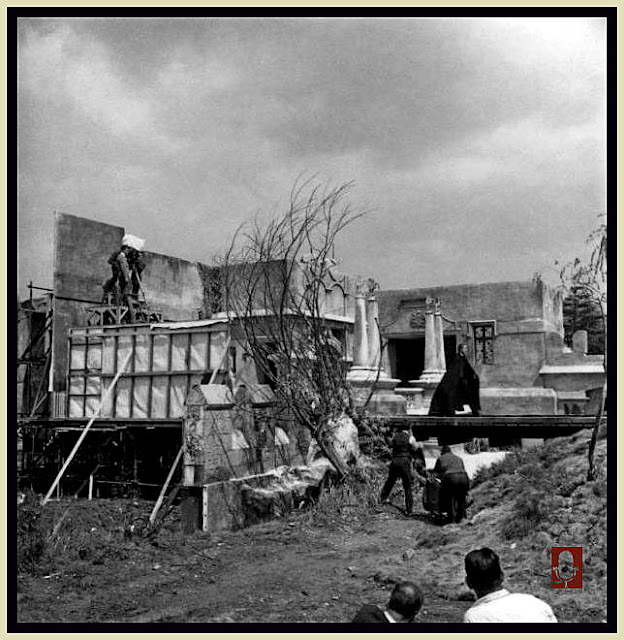CAST:
Andrew Keir (Father Shandor), Christopher
Lee (Count Dracula), Francis Matthews (Charles Kent), Barbara Shelley
(Helen Kent), Suzan Farmer (Diana Kent), Charles Tingwell (Alan Kent),
Philip Latham (Klove), Thorley Walters (Ludwig)
Director – Terence Fisher, Screenplay – John Sansom, Story – John Elder [Anthony Hinds],
Producer – Anthony Nelson-Keys, Photography – Michael Reed, Music –
James Bernard, Music Supervisor – Philip Martell, Special Effects –
Bowie Films Ltd, Makeup – Roy Ashton, Production Design – Bernard
Robinson. Production Company – Hammer/Seven Arts. UK. 1966.
Two English couples holidaying in
Transylvania are abandoned on the roadside after their coach breaks
down. They are picked up by a driverless black coach and taken to Castle
Dracula where they are granted hospitality by Dracula’s manservant.
During the night, one of the men is attacked and gutted by Dracula’s
manservant and his blood used to revive Dracula. Two of the group manage
to flee the castle. In the village below, they join a local priest in
standing up to destroy Dracula.
Dracula - Prince of Darkness was the third of Hammer’s Dracula films. Unlike the first sequel The Brides of Dracula (1960), Prince of Darkness brings back Christopher Lee who had refused to return to the series until he had established himself as a serious actor first.
The Brides of Dracula worked well despite the absence of Christopher Lee but Prince of Darkness
achieves somewhat less successfully despite Lee’s return. It is a film
that never coheres or gets fired up despite a great deal of potential to
do so. A large part of the problem is Christopher Lee who, while he
returns, gets no dialogue (although Lee claims this was his own choice
because the dialogue he was given was so awful). Reduced to merely
hissing and dilating his red contact lenses, this has the effect of
making Lee much more animalistic – something that Lee conveys most
effectively – but the net result is that the central threat in the film
is like a tiger in a cage, prowling and roaring, but never getting to
pounce.
Certainly, many of the other elements come together well. The opening of the film – warnings to avoid the castle; villagers refusing to acknowledge its existence even though it sits in front of their eyes; travellers abandoned in the middle of nowhere and then the appearance of a mysterious black coaches harnessed to horses that have wills of their own; and the castle, which is conversely shown to be welcoming with dinner laid out and a fire stoked up, even luggage placed in their respective rooms – builds an increasing sense of unease.

This erupts in a shock sequence where Charles Tingwell is stabbed and his body is hoisted upside down over the catafalque containing Dracula’s ashes and the throat slit to spill his blood, which brings the ashes to life. It is a conceptually remarkable sequence – one that created considerable controversy at the time, blasphemous inversions of The Crucifixion being seen in it and all – although today seems tame.




The most remarkable sequence in the film is
the scene where Barbara Shelley is held down on a table, hissing and
writhing, as a stake is hammered into her heart by the dispassionate
priesthood. It is perhaps the most potent image of sexual repression in
all of British horror cinema. Indeed, Dracula - Prince of Darkness,
more than any of the Hammer Draculas, embodies the recurrent image of
sexual repression threatening to emerge to tear Victorian society apart
and its dispassionate elimination by men of reason.

The travellers are deliberately set up as representatives of English genteel in order to be torn apart – the strongest image of this polarity is the turning of the prim, uptight and anxious Barbara Shelley into a voluptuous vampire, begging Francis Matthews “Give us a kiss.” The sexual overtones in the scene where Christopher Lee causes Suzan Farmer to kneel and drink from the cut he opens with his fingernail in his chest are incredibly vivid.

The travellers are deliberately set up as representatives of English genteel in order to be torn apart – the strongest image of this polarity is the turning of the prim, uptight and anxious Barbara Shelley into a voluptuous vampire, begging Francis Matthews “Give us a kiss.” The sexual overtones in the scene where Christopher Lee causes Suzan Farmer to kneel and drink from the cut he opens with his fingernail in his chest are incredibly vivid.
Hammer’s other Dracula films are:– Dracula/The Horror of Dracula (1958), The Brides of Dracula (1960), Dracula Has Risen from the Grave (1968), Taste the Blood of Dracula (1970), Scars of Dracula (1971), Dracula A.D. 1972 (1972), The Satanic Rites of Dracula/Count Dracula and His Vampire Bride (1973) and The Legend of the 7 Golden Vampires/The Seven Brothers Meet Dracula (1974).
Terence Fisher’s other genre films are:– the sf films The Four-Sided Triangle (1953) and Spaceways (1953), The Curse of Frankenstein (1957), Dracula/The Horror of Dracula (1958), The Revenge of Frankenstein (1958), The Hound of the Baskervilles (1959), The Man Who Could Cheat Death (1959), The Mummy (1959), The Stranglers of Bombay (1959), The Brides of Dracula (1960), The Two Faces of Dr Jekyll (1960), The Curse of the Werewolf (1961), The Phantom of the Opera (1962), The Gorgon (1964), Frankenstein Created Woman (1967), The Devil Rides Out/The Devil’s Bride (1968), Frankenstein Must be Destroyed (1969) and Frankenstein and the Monster from Hell (1973), all for Hammer. Outside of Hammer, Fisher has made the Old Dark House comedy The Horror of It All (1964) and the alien invasion films The Earth Dies Screaming (1964), Island of Terror (1966) and Night of the Big Heat (1967).
Review: Richard Schieb
Images: Marcus Brooks
Review: Richard Schieb
Images: Marcus Brooks

















A great film and a great review thank you.
ReplyDeleteBeautiful!
ReplyDelete